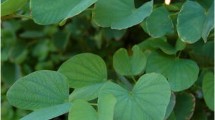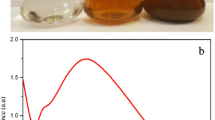Abstract
Mosquitoes (Diptera: Culicidae) act as vectors of important pathogens and parasites, such as malaria, dengue, chikungunya, Japanese encephalitis and lymphatic filariasis. The use of synthetic mosquitocides often leads to high operational costs and adverse non-target effects. Recently, plant-borne compounds have been proposed for rapid extracellular biosynthesis of mosquitocidal nanoparticles. However, the impact of these nanomosquitocides against biological control agents of mosquito larval populations has been poorly studied. In this research, we biosynthesized silver nanoparticles (Ag NP) using the Barleria cristata leaf extract as a reducing and stabilizing agent. The biosynthesis of Ag NP was confirmed analyzing the excitation of surface plasmon resonance using ultraviolet–visible (UV–vis) spectrophotometry. Scanning electron microscopy (SEM) and transmission electron microscopy (TEM) showed the clustered and irregular shapes of Ag NP. The presence of silver was confirmed by energy-dispersive X-ray (EDX) spectroscopy. Fourier transform infrared (FTIR) spectroscopy investigated the identity of secondary metabolites, which may also act as Ag NP capping agents. The acute toxicity of B. cristata leaf extract and biosynthesized Ag NP was evaluated against larvae of Anopheles subpictus, Aedes albopictus, and Culex tritaeniorhynchus. Compared to the leaf aqueous extract, biosynthesized Ag NP showed higher toxicity against An. subpictus, Ae. albopictus, and Cx. tritaeniorhynchus with lethal concentration (LC)50 values of 12.46, 13.49, and 15.01 μg/mL, respectively. Notably, biosynthesized Ag NP were found safer to non-target organisms Diplonychus indicus, Anisops bouvieri, and Gambusia affinis, with respective LC50 values ranging from 633.26 to 866.92 μg/mL. Overall, our results highlight that B. cristata-fabricated Ag NP are a promising and eco-friendly tool against young instar populations of mosquito vectors of medical and veterinary importance.






Similar content being viewed by others
References
Ahmad A, Mukherjee M, Mandal D, Senapati S, Khan MI, Kumar R, Sastry M (2003) Extracellular biosynthesis of silver nanoparticles using the fungus Fusarium oxysporum. Colloids Surf B: Biointerfaces 28:313–318
Amer A, Mehlhorn H (2006a) Larvicidal effects of various essential oils against Aedes, Anopheles, and Culex larvae (Diptera, Culicidae). Parasitol Res 99:466–472
Amer A, Mehlhorn H (2006b) Repellency effect of forty-one essential oils against Aedes, Anopheles and Culex mosquitoes. Parasitol Res 99:478–490
Ankamwar B, Chaudhary M, Sastry M (2005) Gold nanotriangles biologically synthesized using tamarind leaf extract and potential application in vapor sensing. Synth React Inorg Met-Org Nano-Met Chem 35:19–26
Benelli G (2015a) Research in mosquito control: current challenges for a brighter future. Parasitol Res 114:2801–2805
Benelli G (2015b) Plant-borne ovicides in the fight against mosquito vectors of medical and veterinary importance: a systematic review. Parasitol Res 114:3201–3212
Benelli G (2016) Plant-mediated biosynthesis of nanoparticles as an emerging tool against mosquitoes of medical and veterinary importance: a review. Parasitol Res. doi:10.1007/s00436-015-4800-9
Benelli G, Canale A, Conti B (2013a) Eco-friendly control strategies against the Asian tiger mosquito, Aedes albopictus (Diptera: Culicidae): repellency and toxic activity of plant essential oils and extracts. Pharmacologyonline 47:44–51
Benelli G, Flamini G, Fiore G, Cioni PL, Conti B (2013b) Larvicidal and repellent activity of the essential oil of Coriandrum sativum L. (Apiaceae) fruits against the filariasis vector Aedes albopictus Skuse (Diptera: Culicidae). Parasitol Res 112:1155–1161
Benelli G, Murugan K, Panneerselvam C, Madhiyazhagan P, Conti B, Nicoletti M (2015) Old ingredients for a new recipe? Neem cake, a low-cost botanical by-product in the fight against mosquito-borne diseases. Parasitol Res 114:391–397
Bhattacharyya A, Bhaumik A, Rani PU, Mandal S, Epidi TT (2010) Nanoparticles-a recent approach to insect pest control. Afr J Biotechnol 9:3489–3493
Bossche V, Coetzer JA (2008) Climate change and animal health in Africa. Rev Sci Tech 27:551–562
Deo PG, Hasan SB, Majumdar SK (1988) Toxicity and suitability of some insecticides for household use. Int Pest Control 30:118–129
Finney DJ (1971) Probit analysis. Cambridge University Press, London, pp 68–78
Goodsell DS (2004) Bionanotechnology: lessons from nature. Wiley, Hoboken
Govindarajan M (2016) Green synthesized silver nanoparticles: a potential new insecticide for mosquito control. Springer International Publishing Switzerland, H. Mehlhorn (ed.), Nanoparticles in the Fight Against Parasites - Parasitology Research Monographs Chapter 7, doi: 10.1007/978-3-319-25292-6_7 (ISSN: 2192–3671)
Govindarajan M, Sivakumar R, Rajeswari M, Yogalakshmi K (2012) Chemical composition and larvicidal activity of essential oil from Mentha spicata (Linn.) against three mosquito species. Parasitol Res 110:2023–2032
Govindarajan M, Sivakumar R, Rajeswary M, Yogalakshmi K (2013) Chemical composition and larvicidal activity of essential oil from Ocimum basilicum (L.) against Culex tritaeniorhynchus, Aedes albopictus and Anopheles subpictus (Diptera: Culicidae). Exp Parasitol 134:7–11
Govindarajan M, Rajeswary M, Veerakumar K, Muthukumaran U, Hoti SL, Mehlhorn H, Barnard DR, Benelli G (2015) Novel synthesis of silver nanoparticles using Bauhinia variegata: a recent eco-friendly approach for mosquito control. Parasitol Res. doi:10.1007/s00436-015-4794-3
Haldar B, Haldar G, Chandra (2013) Fabrication, characterization and mosquito larvicidal bioassay of silver nanoparticles synthesized from aqueous fruit extract of putranjiva, Drypetes roxburghii (Wall.). Parasitol Res 112:1451–1459
Klempner MS, Unnasch TR, Hu LT (2007) Taking a bite out of vector-transmitted infectious diseases. N Engl J Med 356:2567–2569
Li S, Shen Y, Xie A, Yu X, Qiu L, Zhang L, Zhang Q (2007) Green synthesis of silver nanoparticles using Capsicum annuum L. extract. Green Chem 9:852–858
Mehlhorn H, Al-Rasheid KA, Al-Quraishy S, Abdel-Ghaffar F (2012) Research and increase of expertise in arachno-entomology are urgently needed. Parasitol Res 110:259–265
Murugan K, Dinesh D, Jenil Kumar P, Panneerselvam C, Subramaniam J, Madhiyazhagan P, Suresh U, Nicoletti M, Alarfaj AA, Munusamy MA, Higuchi A, Mehlhorn H, Benelli G (2015) Datura metel-synthesized silver nanoparticles magnify predation of dragonfly nymphs against the malaria vector Anopheles stephensi. Parasitol Res. doi:10.1007/s00436-015-4710-x
Muthukumaran U, Govindarajan M, Rajeswary M (2015a) Mosquito larvicidal potential of silver nanoparticles synthesized using Chomelia asiatica (Rubiaceae) against Anopheles stephensi, Aedes aegypti, and Culex quinquefasciatus (Diptera: Culicidae). Parasitol Res 114(3):989–999
Muthukumaran U, Govindarajan M, Rajeswary M (2015b) Synthesis and characterization of silver nanoparticles using Gmelina asiatica leaf extract against filariasis, dengue, and malaria vector mosquitoes. Parasitol Res 114:1817–27
Patil CD, Borase HP, Patil SV, Salunkhe RB, Salunke BK (2012) Larvicidal activity of silver nanoparticles synthesized using Pergularia daemia plant latex against Aedes aegypti and Anopheles stephensi and nontarget fish Poecillia reticulata. Parasitol Res 111:555–562
Peng Z, Beckett AN, Engler RJ, Hoffman DR, Ott NL, Simons FER (2004) Immune responses to mosquito saliva in 14 individuals with acute systemic allergic reactions to mosquito bites. J Allergy Clin Immunol 114:1189–1194
Rafiuddin ZZ (2013) Bio-conjugated silver nanoparticles from Ocimum sanctum and role of cetyltrimethyl ammonium bromide. Colloids Surf B: Biointerfaces 108:90–94
Ramanibai R, Velayutham K (2015) Bioactive compound synthesis of Ag nanoparticles from leaves of Melia azedarach and its control for mosquito larvae. Res Vet Sci 98:82–88
Rawani A, Ghosh A, Chandra G (2013) Mosquito larvicidal and antimicrobial activity of synthesized nano-crystalline silver particles using leaves and green berry extract of Solanum nigrum L. (Solanaceae: Solanales). Acta Trop 128:613–622
Roni M, Murugan K, Panneerselvam C, Subramaniam J, Nicoletti M, Madhiyazhagan P, Dinesh D, Suresh U, Khater HF, Wei H, Canale A, Alarfaj AA, Munusamy MA, Higuchi A, Benelli G (2015) Characterization and biotoxicity of Hypnea musciformis-synthesized silver nanoparticles as potential eco-friendly control tool against Aedes aegypti and Plutella xylostella. Ecotoxicol Environ Saf 121:31–38
Shankar SS, Rai A, Ahmad A, Sastry M (2004) Biosynthesis of silver and gold nanoparticles from extracts of different parts of the Geranium plant. Appl Nanotechnol 1:69–77
Shanmugam N, Rajkamal P, Cholan S, Kannadasan N, Sathishkumar K, Viruthagiri G, Sundaramanickam A (2014) Biosynthesis of silver nanoparticles from the marine seaweed Sargassum wightii and their antibacterial activity against some human pathogens. Appl Nanosci 4:881–888
Sharmin T, Ahmed S, Ilam F (2013) Biological activities of Barleria cristata. J Pharmacol Pharmacother 2(2):367–371
Singh BP, Hatton BJ, Singh B, Cowie AL, Kathuria A (2010) Influence of biochars on nitrous oxide emission and nitrogen leaching from two contrasting soils. J Environ Qual 39:1–12
Sivagnaname N, Kalyanasundaram M (2004) Laboratory evaluation of methanolic extract of Atlantia monophylla (Family: Rutaceae) against immature stages of mosquitoes and non-target Organisms. Mem Inst Oswaldo Cruz 99:115–118
Subarani S, Sabhanayakam S, Kamaraj C (2013) Studies on the impact of biosynthesized silver nanoparticles (Ag NPs) in relation to malaria and filariasis vector control against Anopheles stephensi Liston and Culex quinquefasciatus Say (Diptera: Culicidae). Parasitol Res 112:487–499
Tavakoli F, Salavati-Niasari M, Mohandes F (2015) Green synthesis and characterization of graphene nanosheets. Mater Res Bull 63:51–57
Thirunavokkarasu M, Balaji U, Behera S, Panda PK, Mishra BK (2013) Biosynthesis of silver nanoparticles from extract of Desmodium gangeticum (L.) DC. and its biomedical potential. Spectrochim Acta Part A Mol Biomol Spectrosc 116:424–427
Veerakumar K, Govindarajan M, Rajeswary M, Muthukumaran U (2014) Low-cost and eco-friendly green synthesis of silver nanoparticles using Feronia elephantum (Rutaceae) against Culex quinquefasciatus, Anopheles stephensi, and Aedes aegypti (Diptera: Culicidae). Parasitol Res 113:1775–1785
Veerekumar K, Govindarajan M, Rajeswary M (2013) Green synthesis of silver nanoparticles using Sida acuta (Malvaceae) leaf extract against Culex quinquefasciatus, Aedes aegypti and Anopheles stephensi (Diptera: Culicidae). Parasitol Res 112:4073–4085
Vivek R, Thangam R, Muthuchelian K, Gunasekaran P, Kaveri K, Kannan S (2012) Green biosynthesis of silver nanoparticles from Annona squamosa leaf extract and its in vitro cytotoxic effect on MCF-7 cells. Process Biochem 47:2405–2410
WHO (2014) Japanese encephalitis. Fact sheet No 386, Geneva
World Health Organization (2005) Guidelines for laboratory and field testing of mosquito larvicides. WHO/CDS/WHOPES/GCDPP/ 2005.13
Zargar M, Hamid AA, Bakar FA, Shamsudin MN, Shameli K, Jahanshiri F, Farahani F (2011) Green synthesis and antibacterial effect of silver nanoparticles using Vitex negundo L. Molecules 6:6667–6676
Acknowledgments
The authors would like to thank the Professor and Head, Department of Zoology, Annamalai University, for the laboratory facilities provided. We also acknowledge the cooperation of staff members of the VCRC (ICMR), Pondicherry.
Author information
Authors and Affiliations
Corresponding authors
Ethics declarations
All applicable international and national guidelines for the care and use of animals were followed. All procedures performed in studies involving animals were in accordance with the ethical standards of the institution or practice at which the studies were conducted.
Conflict of interest
The authors declare that they have no competing interests. Giovanni Benelli is an Editorial Board Member of Parasitology Research. This does not alter the author’s adherence to all the Parasitology Research policies on sharing data and materials.
Rights and permissions
About this article
Cite this article
Govindarajan, M., Benelli, G. Facile biosynthesis of silver nanoparticles using Barleria cristata: mosquitocidal potential and biotoxicity on three non-target aquatic organisms. Parasitol Res 115, 925–935 (2016). https://doi.org/10.1007/s00436-015-4817-0
Received:
Accepted:
Published:
Issue Date:
DOI: https://doi.org/10.1007/s00436-015-4817-0




